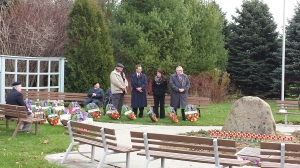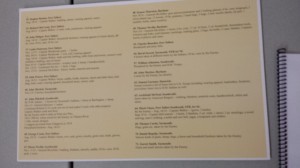World War Wednesdays: The Wars on Film
Perhaps it is just my experience of being a history student who is also in German cinema, but there seems to be a strong connection between those who love history and those who love film. So often when a professor or fellow student is explaining a historical concept, they mention a scene in a film which covers that topic. Perhaps this aspect plays into the historian's constant quest to relive and re-enact the past. It can also be a highly useful and fascinating method to bring to life the events which we read about but have difficulty imagining in real life.
These ideas are what caused me to want to write about this topic, and it is something that plays a major role in my day to day life. I suppose I am a bit predisposed to talk about it after just having finished watching Ken Burns' seven-part documentary The War. Each part is roughly two hours and length, tracing the WWII experiences of four U.S. towns and the people who lived in them. I will be honest, many a tear was shed over the course of the story, and I highly recommend watching it (on Netflix).
What makes a good war film is the ability to make us feel such a depth of emotion. The wars themselves were such a complexity of hardship, togetherness, love and fear. For a film to have the capacity to give its audience a similar emotional experience is something that everyone, not just historians, can appreciate.
Of course, this tradition of impactful war films began during the wars themselves. (Due to technology advancements of the times and my personal preference I will be focusing on some of my favorites of the Second World War). I'm sure (I hope) we've all had the chance to see Casablanca, a true classic, whose infamous lines have become a part of common phrases to this day ("Here's looking at you, kid", "Play it again, Sam", "We'll always have Paris"). This film captures the experience of displacement due to the war, with lost love, and with the threat of world conflict on peoples' personal lives.
 |
|
The United States entered the war in December 1941, after Britain had been fighting for almost three years. It was rare for an enemy to be explicitly stated in Hollywood films much before then, since America provided a great deal of funding and supplies to all sides. The first film to clearly depict the enemy as being Germany was Charlie Chaplin's 1940 satire The Great Dictator (Chaplin was a Socialist himself). After becoming part of the conflict, however, there was no secret as to America's stance. This can be seen in wartime films such as Thirty Seconds Over Tokyo, 49th Parallel, and Mrs. Miniver. There was also the concept of the propaganda war, with Hollywood competing against Dr. Goebbels' team in Germany. Some of the most fascinating works of propaganda come from this time, when companies like Walt Disney and Warner Brothers teamed up with groups such as the U.S. Air Force to create animated cartoons depicting well-loved characters being involved in the war. Disney's "Der Fuhrer's Face", which features Donald Duck sticking it to a group of overweight, dopey Nazis, won the Oscar in 1943 for Best Animated Short. Jack Warner and the Warner Brothers' collaboration with the air force produced such cartoons as "Herr Meets Hare" and "Draftee Daffy" featuring Bugs Bunny and Daffy Duck. These films spoke not only to children but to a full spectrum of audiences, using characters who held a great deal of emotional and ideological sway among fans young and old.
.png) |
| Donald Duck reads Hitler's infamous book, a far cry from the Donald we know today |
Of course, not all films during the war were designed to reinforce ideological beliefs or depict the glory and struggle of real events. Both America and Germany recognized the importance of lighthearted films during times of stress and hardship, and especially in America, the escapist style of film was perfected. This trend was carried on from the films of the Great Depression, which sought to provide an alternate place for audiences to imagine themselves as a way to distract from rough times. In Germany, even these films were covertly filled with propagandistic themes. America's escapist films depicted idealistic, joyful people and situations which gave people not only something else to think about but something to hope for. My favorite example of this is 1940's We Who Are Young featuring Lana Turner, which is the ultimate cheesy and overdramatic film but so incredibly touching. This period perfected the iconic Hollywood love story, featuring the famous pairings of Humphrey Bogart and Lauren Baccall, and actors such as Cary Grant, Barbara Stanwyck, Ingrid Bergmann and Judy Garland.
 |
| Lana Turner and John Shelton in We Who Are Young |
Even to this day, filmmakers continue to create new depictions of wartime stories. This year saw the release of box office hits Monuments Men and Fury. Recent times have provided just as many classics as those actually from the war, such as Saving Private Ryan, Valkyrie, Inglorious Basterds, The Boy in the Striped Pyjamas, Defiance, and Nuremberg. All of these are so well loved by both lovers of history and film fans. They give us the gift of seeing our past as close as possible to the way it really was, which is such an amazing experience. It is so fascinating to know that the ability to see a depiction of the way things really happened is just a click away.
Have you seen any of the films I discussed? Do you have any favorite war films that you didn't see mentioned? I'd love to hear from you!
Thanks for reading,
Delany



.png)




%2BCow%2BBell%2B(a).JPG)
%2BCow%2BBell%2B(b).JPG)
















 While you are reading this post, please take a moment to thank all those who have served to protect our rights and freedoms, and those who remained to serve in others way on the home front.
While you are reading this post, please take a moment to thank all those who have served to protect our rights and freedoms, and those who remained to serve in others way on the home front. 



%2BButter%2BChurn%2B(Barrell%2BChurn)%2B(b).JPG)
%2BButter%2BChurn%2B(Barrell%2BChurn)%2B(a).JPG)